| Key features and emergency approach procedures for six (6) of the most common types of alternative-fueled vehicles (AFV). |
|---|
| The first objective is to identify the specific type of alternative-fueled vehicle. Look for special fuel ports, distinctive profiles, and any written markings on the vehicle. Except for selected local areas, these vehicles are not required to be identified and there are no standardized placards, logos or symbols for the identification of each type of AFV as there are for railroad tank cars and trucks. Listed below are several examples of identifying symbols for each alternative-fueled vehicle, however, these symbols may vary in size and color. |
![]()
| LIQUEFIED PETROLEUM GAS (LPG) AND COMPRESSED NATURAL GAS (CNG) |
|---|
| Examples of identification symbols for LPG-fueled vehicles are: |


 |
| Examples of identification symbols for CNG-fueled vehicles are: |

 |
| LOCATING THE LPG OR CNG FUEL CONTAINERS |
| In most LPG or CNG vehicles, containers will be found in the trunk area, under the side panel of a van or school bus, on the frame, or in the bed of a pick up truck. Expect a majority of the vehicles to be owned by a fleet service such as buses, taxi cabs, or utility companies. |
| HANDLING EMERGENCY INCIDENTS |
| If the vehicle is not on fire and no obvious leak is detected, stabilize and secure the vehicle by setting the brake, utilizing wheel chocks or other forms of cribbing as needed. Then turn off the vehicle's ignition and turn the gas cylinder valve handle to the �off� position. |
| If the vehicle is on fire or a leak is detected, do not approach the vehicle. Secure the scene with non-sparking markers or cones. DO NOT USE FLARES! |
| Approaching the CNG or LPG vehicle that is leaking fuel or on fire should only be attempted when wearing proper clothing and self-contained breathing apparatus. If you do not have the proper protective gear, equipment and training to deal with fire or HazMat emergencies, do not approach the vehicle. Remember, in most cases, an alternative-fueled vehicle in a crash should not require a HazMat response. |
| The greatest hazard of the LPG containers exposed to fire or extreme heat is BLEVE (boiling liquid/expanding vapor explosion). However, a CNG container exposed to fire can also fail, releasing dangerous amounts of fuel and/or flame. When LPG fuel containers become compromised, the fuel converts from a liquid to a vapor that could rapidly produce a sizeable vapor cloud which may ignite and flash back to the fuel source. |
![]()
| METHANOL AND ETHANOL |
|---|
| Examples of identification symbols for methanol-fueled vehicles are: |

 |
| Examples of identification symbols for ethanol-fueled vehicles are: |

|
| LOCATING THE METHANOL AND ETHANOL TANKS |
| Both of these fuels are used in the vehicle's existing fuel tanks. Bus fleets are common users of these two types of fuels. |
| HANDLING EMERGENCY INCIDENTS |
| If there is no fire or leak, carefully approach the vehicle, turn off the driver's ignition switch and set the parking brake or use wheel chocks to secure the vehicle. |
| If fire is present, stay away from the vehicle, secure the area and deny entry. Caution: a fire fueled by methanol or ethanol burns bright blue and can be difficult to see on a clear day. |
| If there is an obvious leak, approach the vehicle, but use the same caution as when working around a traditional-fueled vehicle. |
| Safety Alert from the Department of Transportation Ethanol and Gasoline Fuel Mixtures |
| ERG2004 Guide 127 Flammable Liquids |
| Handbook for Handling, Storing, and Dispensing E85 |
| Ethanol: Response Considerations (added 08/31/2016) |
| DO NOT USE FLARES. |
|---|
![]()
| ELECTRIC |
|---|
| Examples of identification symbols for electric-fueled vehicles are: |

 |
| Look for an electric charging port on the side or front of the vehicle, the electric logo, a stepped-up roof line or a distinctive profile. |
| LOCATING THE ELECTRIC BATTERIES |
| These vehicles are powered by batteries, as high as 300 volts, usually located under the hood, in the trunk or under the vehicle. A separate, traditional 12 volt battery is still needed to operate the vehicle's electric features such as the radio or headlights. |
| HANDLING EMERGENCY INCIDENTS |
| If there is no fire or battery liquid leak, carefully approach the vehicle, turn off the driver's off/on switch, and set the parking brake or use wheel chocks to secure the vehicle. |
| If smoke is visible, NO ONE SHOULD APPROACH THE VEHICLE without selfcontained breathing apparatus. Toxic fumes and vapors from damaged batteries can be carried in the smoke or steam. |
| DO NOT USE FLARES! |
|---|
| Never cut into the battery pack or the traction cable, even if the high voltage has been shut down, because the battery pack can remain charged. |
| Since there still may be toxic fumes present around the vehicle after the fire is contained, only those with proper protective gear, equipment and training should participate in the cleanup. |
| WHAT IS A HYBRID VEHICLE? From the Maryland Fire & Rescue Institute. |
| Responding to Hybrid Vehicle Incidents Quick Reference Guide |
![]()
| HYDROGEN: LIQUID, COMPRESSED, and FUEL CELLS |
|---|
| Examples of identification symbols for hydrogen-fueled vehicles are: |
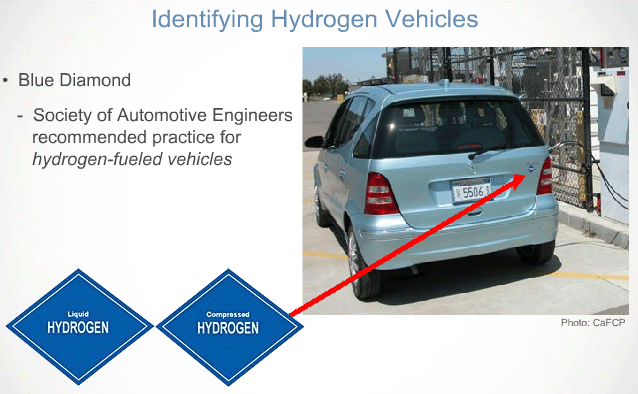 |
| All of the major auto manufacturers are developing vehicles powered by hydrogen. Although it will be some time before they're widely available to consumers, you may have already seen hydrogen cars or buses in your area as part of ongoing demonstration and evaluation programs. |
| Hydrogen is highly flammable; it only takes a small amount of energy to ignite it and make it burn. It also has a wide flammability range, meaning it can burn when it makes up 4 to 74 percent of the air by volume. | Hydrogen burns with a pale-blue, almost-invisible flame, making hydrogen fires difficult to see. Hydrogen gas is odorless and colorless, and a hydrogen flame is nearly invisible in the daylight. |
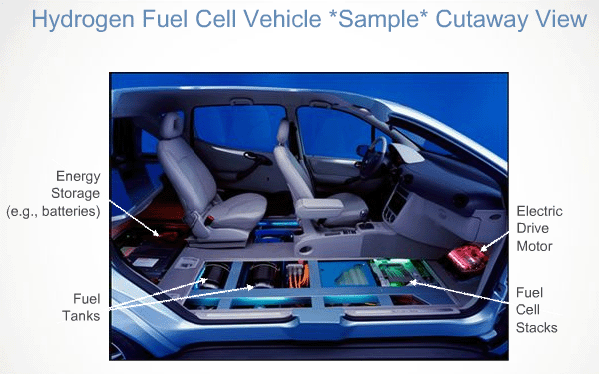 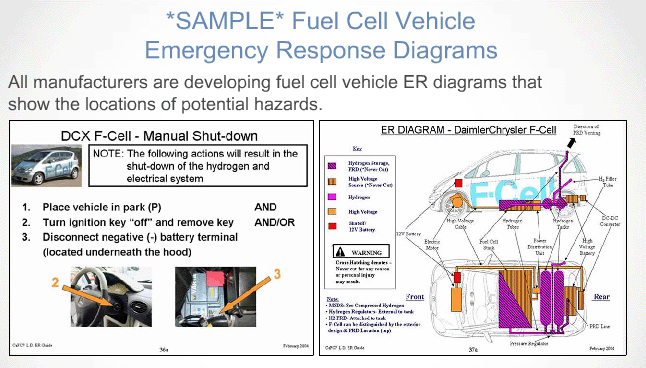 | Please remember that vehicle configurations may change as hydrogen and fuel cell technologies continue to develop and evolve. |
| HYDROGEN / GASOLINE |
|---|
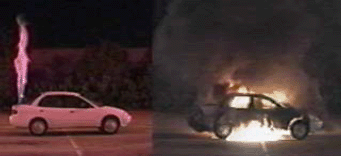 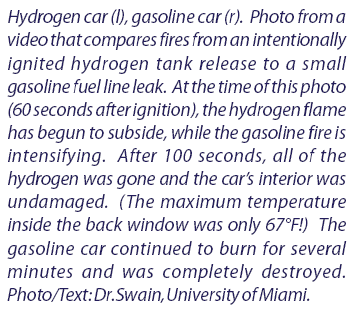 |
| Biodiesel |
|---|
| Biodiesel is a biodegradable, nontoxic, and clean-burning fuel that can be made from any fat or vegetable oil, including recycled cooking oil. Because it contains no petroleum or other fossil fuels, biodiesel emits virtually no sulfur, aromatics, particulates, or carcinogenic compounds and is thus a safer and healthier alternative than petroleum diesel. |
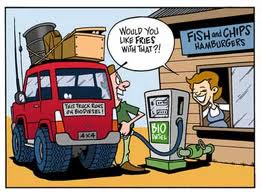 |
| Biodiesel: Response Considerations (added 08/2016) |
| HANDLING EMERGENCY INCIDENTS | |
|---|---|
| When approaching an incident, stay upwind. Listen for venting gas and watch for thermal waves that could signal hydrogen flames. | |
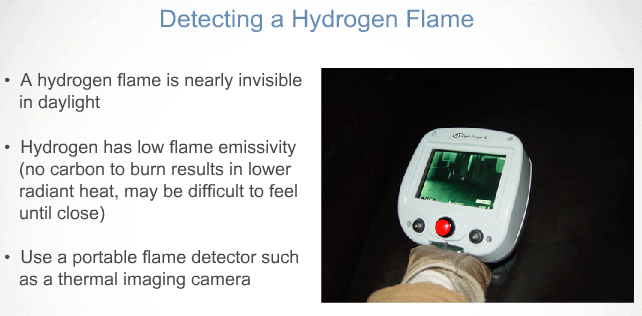 | |
| Cutting through the bottom of a vehicle below the floorline is not recommended since hydrogen fuel lines, high-voltage electrical lines, batteries, and fuel cell units are commonly located below the floorline. | |
| Let a hydrogen fire burn, if safe to do so. | |
| Hydrogen is 14 times lighter than air, so it rises and disperses rapidly. |
![]()
| FINAL THOUGHTS... |
|
| Post-crash safety precautions are critical, and it is imperative that emergency personnel familiarize themselves with the differences between alternative and conventional fuels. |
 Emergency Response Guides for Hybrid Vehicles. |
|---|
Return to Vehicle Fires.
![]()
![]()
 |
 |
 |
 |
 To Kolb |
|---|